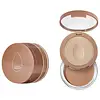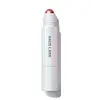beautyblender Bounce Magic Fit Creamy Bronzer & Highlighter Duo Versus Haus Labs By Lady Gaga Bio-Radiant Glassy Balm Highlighter Stick
What's inside
What's inside
 Key Ingredients
Key Ingredients

 Benefits
Benefits

 Concerns
Concerns

 Ingredients Side-by-side
Ingredients Side-by-side

Mica
Cosmetic ColorantVinyl Dimethicone/Methicone Silsesquioxane Crosspolymer
Hydrogenated Polydecene
EmollientHdi/Trimethylol Hexyllactone Crosspolymer
Octyldodecyl Stearoyl Stearate
EmollientEthylhexyl Palmitate
EmollientDiisostearyl Malate
EmollientOctyldodecanol
EmollientPentaerythrityl Tetraisostearate
EmollientPolybutene
Lauroyl Lysine
Skin ConditioningZinc Oxide
Cosmetic ColorantSilica
AbrasiveTocopheryl Acetate
AntioxidantAscorbyl Palmitate
AntioxidantSodium Hyaluronate
HumectantAmorphophallus Konjac Root Powder
AbrasiveTrihydroxystearin
Skin ConditioningPentaerythrityl Tetra-Di-T-Butyl Hydroxyhydrocinnamate
AntioxidantCaprylyl Glycol
EmollientPhenoxyethanol
PreservativeTriethoxycaprylylsilane
Synthetic Fluorphlogopite
Tin Oxide
AbrasiveCI 77491
Cosmetic ColorantCI 77891
Cosmetic ColorantIron Oxides
Dimethicone
EmollientIsononyl Isononanoate
EmollientOzokerite
Emulsion StabilisingTrimethylsiloxysilicate
EmollientCitric Acid
BufferingSilica Dimethyl Silylate
EmollientAlumina
AbrasiveCI 45410
Cosmetic ColorantMica, Vinyl Dimethicone/Methicone Silsesquioxane Crosspolymer, Hydrogenated Polydecene, Hdi/Trimethylol Hexyllactone Crosspolymer, Octyldodecyl Stearoyl Stearate, Ethylhexyl Palmitate, Diisostearyl Malate, Octyldodecanol, Pentaerythrityl Tetraisostearate, Polybutene, Lauroyl Lysine, Zinc Oxide, Silica, Tocopheryl Acetate, Ascorbyl Palmitate, Sodium Hyaluronate, Amorphophallus Konjac Root Powder, Trihydroxystearin, Pentaerythrityl Tetra-Di-T-Butyl Hydroxyhydrocinnamate, Caprylyl Glycol, Phenoxyethanol, Triethoxycaprylylsilane, Synthetic Fluorphlogopite, Tin Oxide, CI 77491, CI 77891, Iron Oxides, Dimethicone, Isononyl Isononanoate, Ozokerite, Trimethylsiloxysilicate, Citric Acid, Silica Dimethyl Silylate, Alumina, CI 45410
Pentaerythrityl Tetraisostearate
EmollientOctyldodecanol
EmollientPolybutene
Diisostearyl Malate
EmollientSynthetic Wax
AbrasiveSynthetic Fluorphlogopite
Bis-Diglyceryl Polyacyladipate-2
EmollientVp/Hexadecene Copolymer
Arnica Montana Flower Extract
MaskingUndaria Pinnatifida Extract
Skin ConditioningCrithmum Maritimum Extract
Skin ConditioningSodium Hyaluronate
HumectantSqualane
EmollientPrunus Armeniaca Kernel Oil
MaskingPseudozyma Epicola/Camellia Sinensis Seed Oil Ferment Extract Filtrate
HumectantPseudozyma Epicola/Apricot Kernel Oil/Olive Fruit Oil/Sunflower Seed Oil/Sweet Almond Oil/(Angelica Gigas/Lithospermum Erythrorhizon) Root Extract Ferment Extract Filtrate
Pseudozyma Epicola/Sunflower Seed Oil Ferment Extract Filtrate
Emulsion StabilisingCaprylic/Capric Triglyceride
MaskingRicinus Communis Seed Oil
MaskingPentaerythrityl Tetra-Di-T-Butyl Hydroxyhydrocinnamate
AntioxidantHydrogenated Castor Oil
EmollientTin Oxide
AbrasiveCI 77491
Cosmetic ColorantCI 77891
Cosmetic ColorantPentaerythrityl Tetraisostearate, Octyldodecanol, Polybutene, Diisostearyl Malate, Synthetic Wax, Synthetic Fluorphlogopite, Bis-Diglyceryl Polyacyladipate-2, Vp/Hexadecene Copolymer, Arnica Montana Flower Extract, Undaria Pinnatifida Extract, Crithmum Maritimum Extract, Sodium Hyaluronate, Squalane, Prunus Armeniaca Kernel Oil, Pseudozyma Epicola/Camellia Sinensis Seed Oil Ferment Extract Filtrate, Pseudozyma Epicola/Apricot Kernel Oil/Olive Fruit Oil/Sunflower Seed Oil/Sweet Almond Oil/(Angelica Gigas/Lithospermum Erythrorhizon) Root Extract Ferment Extract Filtrate, Pseudozyma Epicola/Sunflower Seed Oil Ferment Extract Filtrate, Caprylic/Capric Triglyceride, Ricinus Communis Seed Oil, Pentaerythrityl Tetra-Di-T-Butyl Hydroxyhydrocinnamate, Hydrogenated Castor Oil, Tin Oxide, CI 77491, CI 77891
Ingredients Explained
These ingredients are found in both products.
Ingredients higher up in an ingredient list are typically present in a larger amount.
Ci 77491 is also hydrated iron III oxide. It's sole purpose is to give a red/pink hue to products.
Iron III oxides are classified as inorganic chemicals for coloring.
Synthetically created Ci 77491 is considered safer than those naturally found. This is because the synthetically created version may contain less impurities. Iron oxides are generally non-toxic and non-allergenic.
Learn more about CI 77491Ci 77891 is a white pigment from Titanium dioxide. It is naturally found in minerals such as rutile and ilmenite.
It's main function is to add a white color to cosmetics. It can also be mixed with other colors to create different shades.
Ci 77891 is commonly found in sunscreens due to its ability to block UV rays.
Learn more about CI 77891Diisostearyl Malate is an emollient and most often used in lip products. It comes from isostearyl alcohol, a fatty acid, and malic acid, an AHA.
As an emollient, Diisostearyl Malate helps create a thin film on your skin to trap moisture in. This helps keep your skin soft and smooth.
Octyldodecanol is a fatty alcohol. It is primarily used to enhance the texture of products.
As an emulsifier, Octyldodecanol helps prevent the oils and waters from separating. It also prevents ingredients from creating foam when shaken.
Octyldodecanol is created by reducing fatty acid to an alcohol.
Due to its high molecular weight, it does not get absorbed into the skin.
Learn more about OctyldodecanolPentaerythrityl Tetra-Di-T-Butyl Hydroxyhydrocinnamate (long name, huh?) is a synthetic antioxidant.
It is used to help stabilize other antioxidants or prevent the color from changing in a product.
As an antioxidant, it helps fight free-radical molecules. Free-radical molecules are capable of damaging our cells and other genetic material. Thus, antioxidants may reduce the signs of aging.
This ingredient is oil-soluble.
Learn more about Pentaerythrityl Tetra-Di-T-Butyl HydroxyhydrocinnamatePentaerythrityl Tetraisostearate is derived from isostearic acid. It is an emollient and emulsifier.
The highest concentration of this ingredient is found in lipsticks.
This ingredient is minimally water soluble and may not be Malassezia folliculitis, or fungal-acne safe.
Learn more about Pentaerythrityl TetraisostearatePolybutene is used to help control the viscosity of a product. This just means it helps adjusts the texture.
It is a polymer and does not get absorbed into the skin due to its large size.
Studies found this ingredient did not irritate skin in concentrations below 15%.
Learn more about PolybuteneSodium Hyaluronate is hyaluronic acid's salt form. It is commonly derived from the sodium salt of hyaluronic acid.
Like hyaluronic acid, it is great at holding water and acts as a humectant. This makes it a great skin hydrating ingredient.
Sodium Hyaluronate is naturally occurring in our bodies and is mostly found in eye fluid and joints.
These are some other common types of Hyaluronic Acid:
Learn more about Sodium HyaluronateSynthetic Fluorphlogopite is the synthethic version of mica. It consists of fluorine, aluminum and silicate.
Synthetic Fluorphlogopite is used to add volume to products.
It is considered non-irritating on the skin.
Learn more about Synthetic FluorphlogopiteTin Oxide is an inorganic oxide used to add opacity and volume to a product. In nature, it is already found in mineral form. The main ore of tin is an opaque and shiny mineral called casseterite.
Tin Oxide helps remove translucency in a product, or make it more opaque. Besides adding opacity, tin oxide is used for bulking to add volume.